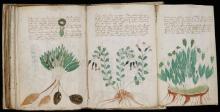The Voynich Manuscript is one of the world's oldest and most enduring mysteries. This hand-written book has been carbon dated to between the years 1401 and 1438, about 200 years before Shakespeare's day.
We know precious little about the manuscript, which is named after the book dealer who purchased it in 1912. The book currently lives at Yale University, where it continues to be studied by cryptologists and mystery lovers from around the world.
If you didn't know what you were looking at, you might suppose you were paging through any other medieval manuscript. It was written with a quill pen, from left to right, with a flourish-y sort of text that is just this side of calligraphic. The text is frequently broken by illustrations, which no doubt are related to the text in some way. It might seem to be a text book or some other sort of knowledge compendium. As you examine the pages you might assume that, since the words make no sense, it was written in a language other than English.
And on that point, you would be entirely correct. For as far as we can tell, the Voynich manuscript is written in no language at all. It is written in what looks for all the world like words and sentences and paragraphs, but the symbols are not any known letters, and they do not form the words of any known language.
Theories about the Voynich manuscript abound, and people are forever proclaiming that they have solved it. But to date, none have.
(I recently ran across the website of someone who claims that the manuscript is written in Italian anagrams, and who sniffs that it "is therefore not as complicated as it first appears." And who then goes on to "translate" the names of a few illustrated vegetables, while getting the identification quite wrong. For example, the plant whose name she translates as "garlic" is clearly not garlic, and the plant's name she translates as "licorice" is clearly not a licorice plant. She also translates only three of the manuscript's 240+ pages, which made me wonder why her effort trailed off after misidentifying a few pages of plants.)
The only thing we can say for sure about the Voynich manuscript is that someone went to a lot of trouble to create it. It covers topics (or seems to) from medical to botanical, and the words visually flow in a very natural fashion. There are two basic possibilities: that the book has meaning, or that it does not.
If it has meaning, then is it encoded? And if so, how? A code which has remained un-cracked after passing through the hands of hundreds of years of ownership would be a valuable tool indeed.
If it has no meaning, then is it the work of a madman, rambling on in a private language which doesn't really exist? Or is it a hoax, and if so, what could possibly be the use?
We know precious little about the manuscript, which is named after the book dealer who purchased it in 1912. The book currently lives at Yale University, where it continues to be studied by cryptologists and mystery lovers from around the world.
If you didn't know what you were looking at, you might suppose you were paging through any other medieval manuscript. It was written with a quill pen, from left to right, with a flourish-y sort of text that is just this side of calligraphic. The text is frequently broken by illustrations, which no doubt are related to the text in some way. It might seem to be a text book or some other sort of knowledge compendium. As you examine the pages you might assume that, since the words make no sense, it was written in a language other than English.
And on that point, you would be entirely correct. For as far as we can tell, the Voynich manuscript is written in no language at all. It is written in what looks for all the world like words and sentences and paragraphs, but the symbols are not any known letters, and they do not form the words of any known language.
Theories about the Voynich manuscript abound, and people are forever proclaiming that they have solved it. But to date, none have.
(I recently ran across the website of someone who claims that the manuscript is written in Italian anagrams, and who sniffs that it "is therefore not as complicated as it first appears." And who then goes on to "translate" the names of a few illustrated vegetables, while getting the identification quite wrong. For example, the plant whose name she translates as "garlic" is clearly not garlic, and the plant's name she translates as "licorice" is clearly not a licorice plant. She also translates only three of the manuscript's 240+ pages, which made me wonder why her effort trailed off after misidentifying a few pages of plants.)
The only thing we can say for sure about the Voynich manuscript is that someone went to a lot of trouble to create it. It covers topics (or seems to) from medical to botanical, and the words visually flow in a very natural fashion. There are two basic possibilities: that the book has meaning, or that it does not.
If it has meaning, then is it encoded? And if so, how? A code which has remained un-cracked after passing through the hands of hundreds of years of ownership would be a valuable tool indeed.
If it has no meaning, then is it the work of a madman, rambling on in a private language which doesn't really exist? Or is it a hoax, and if so, what could possibly be the use?
Photo credit: Wikimedia Commons
